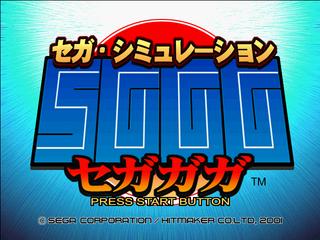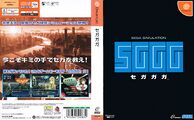Segagaga (original) (raw)
n/a
 |
|---|
| Segagaga |
| System(s): Sega Dreamcast |
| Publisher: Sega |
| Developer: |
| Supporting companies: Toei Animation (animation) |
| Peripherals supported: Dreamcast VGA Box, Jump Pack, Visual Memory Unit |
| Genre: Simulation RPG[1][2], Simulation[3] |
| Number of players: 1 |
Release Date RRP Code  JP 2001-05-31[2] ¥5,800 (6,090)5,800e[2] HDR-0171 JP 2001-05-31[2] ¥5,800 (6,090)5,800e[2] HDR-0171   JP (Dorikore) 2003-03-20[2] ¥2,800 (2,940)2,800e[2] HDR-0214 JP (Dorikore) 2003-03-20[2] ¥2,800 (2,940)2,800e[2] HDR-0214  JP (Shokai Genteiban) 2001-03-29[2] ¥9,800 (10,290)9,800e[2] HDR-0083 JP (Shokai Genteiban) 2001-03-29[2] ¥9,800 (10,290)9,800e[2] HDR-0083   JP (Tsuujou-ban) 2001-03-29[2] ¥5,800 (6,090)5,800e[2] HDR-0151 JP (Tsuujou-ban) 2001-03-29[2] ¥5,800 (6,090)5,800e[2] HDR-0151  |
Segagaga (セガガガ) (or SGGG) is an RPG developed by Hitmaker and published by Sega for the Sega Dreamcast in 2001 released only in Japan.
Contents
- 1 Story
- 2 History
- 3 Production credits
- 4 Magazine articles
- 5 Screenshots
- 6 Physical scans
- 7 Technical information
- 8 External links
- 9 References
Story
The game is set in 2025, with Sega commanding just 3% of the home console market and their last project making little impact. Out of desperation, the "Segagaga project" is initiated, in which two young children are to pull Sega from the brink of destruction and gain complete control of the market, currently owned by the evil DOGMA Corporation. In reality, it was the Dreamcast in 2001 struggling to maintain a sizeable share of the market, as rivals Sony made gains with their PlayStation 2 console.
Many Sonic Team properties show up in cameos within the game. As well making brief appearances in the intro sequence and created software within the game, items such as the "Piko Hammer" are available. Also, characters such as Nei (from Phantasy Star), Ristar, NiGHTS and Sonic the Hedgehog can be recruited as programmers for your team.
History
Development
Segagaga was the brainchild of Tetsu Okano, however when the concept was first brought to the management of Sega, it was misinterpreted as a joke and a potential risk to the company's image. A second attempt at acquiring funding caught the attention of Hisao Oguchi, and a development budget was granted.
Segagaga took over two years to develop, but was kept a secret until near release. By this point, Sega's management were willing to try anything that could save the company from further losses, and so the game was released in March of 2001. Nevertheless, _Segagaga'_s release was kept very low-key, and for the first two months was only available via Sega's Sega Direct service. Strong online sales caused the game to be shipped to stores, before receiving a Dorikore re-release two years later.
The game features a number of Sega franchises and references dating back to the likes of the SG-1000, although several legal challenges occurred during production. It is said that out of the 300-or-so issues that could have caused legal concerns, only a third were actually addressed by the team. Some planned features, like references to Ferrari vehicles (OutRun) and Segata Sanshiro were scrapped entirely through fears of legal challenges, however features many were not. For example, the game has a number of "parody games" hidden inside it, which poke fun at various big intellectual properties from Final Fantasy to Mega Man.
The game reportedly had one-hundredth of the budget backing Shenmue. Toei Animation gave Okano a discount on animated footage for the title. Okano also marketed the game himself with a budget of roughly $200 USD, half of which he spent on a wrestling mask to hide his identity. Okano set up four signing locations in Akihabara and rewarded Sega fans which were to all four. He was assisted by Tadashi Takezaki and Taku Sasahara and led to a full page newspaper spread.
The music for the final boss (a shoot-'em-up level where you defeat Sega consoles gone rogue, in stark contrast to the rest of the game and one of the more famous parts of the game) is "The Justice Ray Part 3," written by Technosoft composer Hyakutarou Tsukumo for the ultimately-cancelled Thunder Force VI (though wound up making it to the pre-emptively released "Broken Thunder" soundtrack album). "The Justice Ray Part 1" had appeared in Blast Wind and Part 2 in Thunder Force V. Tez Okano would later head the development of a brand new Thunder Force VI in the years that followed.
This is not the first RPG to have the player manage a video game company - The Tower of Cabin: Cabin Panic did something similar for Microcabin back in 1992.
Release
Initially released exclusively through Sega Direct, Segagaga shipped to retailers on May 17th, 2001. The game's release was only stopped after few days from it because of an organization called Japan Adult children organization , because one of the characters in game had supposedly tried to use the word adult children differently. (The way Sega intended to use the word adult children was straight forward, "a childlike adult but apparently in Japan it means A kid who grew up from an alcoholic parent which is now an adult.) Sega wrote an apology article and the game was taken back in to make alterations
Legacy
Though not quite released at the end of the system's lifespan, Segagaga is often considered to be the swan song of the Dreamcast, being an RPG that satirises Sega's then-current position in the video game marketplace as well as playing homage to the company's achievements over the last twenty years before this game was released.
Production credits
- 声の出演
- 製作: 株式会社ヒットメーカー
- エグゼクティブプロデューサー: 小口 久雄
- 原案 / 美術設計 / プロデュース: 岡野 哲
- 開発: 有限会社サンダーストンジャパン
- ディレクター: 鈴木 裕明
- プランナー: 鈴木 裕明
- プログラム: 新井 朋睦, 岡橋 秀, 宮脇 真吾, 壬生 祐樹, 嶋崎 堅也, 海老塚 靖史, 伊東 昌洋
- グラフィック: 行川 正貴, 平井 隆志, 草薙 亮, 神林 中, 小林 攻
- サウンド: 金子 剛
- ~挿入歌~
- "AKIBA2025"
- 「二人のドリームキャスト」
- 「セガガガマーチ」 Segagaga Main Theme
- 「いつか会えたら・・・」 Segagaga Ending Theme
- ストーリー: うぶかた とう, 岡安 淳司, 岡野 哲, 鈴木 裕明
- スペシャルサンクス: 内藤 智昭, 米田 眞司, 香川 岳史
- アニメーション製作: 東映アニメーション
- プロデューサー: 森下 考三, 馬場 厚成
- キャラクターデザイン
- 作画監督: 上野 ケン
- 製作担当: 島本 武
- 演出: 伊藤 尚佳
- 演出助手: 所 勝美
- 製作進行: 吉田 淑人
- 原画: 奥野 浩行, 大関 紀子, 菅井 嘉浩, 坂本 英明, 久田 和也, 島貫 正弘, 舎官 直樹, 細山 正樹, 鎌田 均, 宗崎 のりよし
- 色指定: 三室 貴子
- 仕上進行: 浅間 陽介
- 動画: 馬渡 久史, 富田 美穂子, 山口 幸俊, 小林 美穂子, 佐藤 恭子, 篠原 悦子, 兼高 里佳, 北原 由加里, 古川 真奈美, 下平 夕子, 秋山 あき子
- デジタル撮影: 岡崎 英央, 谷口 直之, 本官 美津恵, 岡田 由紀, 坂本 治
- デジタル仕上: 大旗 忍, 井浦 祥子, 村本 織子, 星川 麻美, 大谷 和也, 内田 もも, 藤田 潮, 審良 幸司, 徳永 ゆき子, 及川 眞由美, 小久保 真希, 鈴木 陽子, 大村 規子, 露木 奈美, 木村 紘子, 福田 直征, 金森 真紀, 松森 より子, 坂入 希代美, 足立 和也, 田中 唯己郎
- 特別協力: 有限会社コミケット, コミケット準備委員会, 株式会社ビック東海, メッセサンオー, 雑音工房ノイズ, 九十九 百太郎, 長崎 繁, Garow, 悠里, 有限会社アズゲーム, 山西 利治, 甲賀流忍者 八王子支店, みんだなお, 根本 陽平, 岡田 斗司夫, 唐沢 俊一, 斎藤 智晴, 片倉 真二, ヤスダ スズヒト, 斎藤 亜弓, がっぷ獅子丸, クーロン 黒沢, セガグループ各社のみなさん, セガを愛するすべてのみなさん, そして・・・ あなたへ感謝を込めて
- Presented by: Sega
© SEGA CORPORATION / Hitmaker CO. Ltd, 2001#REF!
Source:
In-game credits (JP)
Source:
Uncredited
Magazine articles
Main article: Segagaga/Magazine articles.
Screenshots
Physical scans
| Sega Retro Average |
|---|
| Publication Score Source |
| {{{{{icon}}}|L}} | Division by zero. |
|---|---|
| Based on0 review |
| Sega Retro Average |
|---|
| Publication Version Score Dreamcast Magazine (JP) NTSC-J 67 [5] Dorimaga (JP) NTSC-J 92 [6] Dreamzone (FR) NTSC-J 43 [7] Famitsu (JP) NTSC-J 85 [8] |
 |
72 |
|---|---|
| Based on4 reviews |
Segagaga
| Dreamcast, JP (Tsuujou-ban) |
|---|
   Cover Cover |
 Disc Disc Box (Top) Box (Top) Box (Front) Box (Front) Inner Box (Top) Inner Box (Top) Organiser (Cover) Organiser (Cover) Organiser (pdf) Organiser (pdf) |
| Dreamcast, JP (Shokai Genteiban) |
|---|
 Cover Cover |
 Disc Disc |
Technical information
Main article: Segagaga/Technical information.
External links
- Sega of Japan catalogue pages (Japanese): Dreamcast
References
- ↑ File:Sggg dc jp back cover.jpg
- ↑ 2.0 2.1 2.2 2.3 2.4 2.5 2.6 2.7 2.8 http://sega.jp/dc/010311/ (Wayback Machine: 2015-01-01 14:16)
- ↑ https://sega.jp/history/hard/dreamcast/software.html (Wayback Machine: 2020-11-07 20:31)
- ↑ http://www.hitmaker.co.jp/top/lounge/corumun/site/corumun_txt34.htm (Wayback Machine: 2003-02-22 16:55)
- ↑ Dreamcast Magazine, "2001-10 (2001-04-06,13)" (JP; 2001-03-23), page 23
- ↑ Dorimaga, "2002-18 (2002-10-11)" (JP; 2002-09-27), page 32
- ↑ Dreamzone, "Mai 2001" (FR; 2001-0x-xx), page 42
- ↑ Famitsu, "2001-04-06" (JP; 2001-03-23), page 78
| Segagaga | |||||
|---|---|---|---|---|---|
 |
Main page | Magazine articles | Reception | Technical information Books: Segagaga Perfect File (2001)Music: Segagaga Soundtrack Collection Red (2001) | Segagaga Soundtrack Collection Blue (2001) | Segagaga 5 Original Soundtrack (2006)No results |
